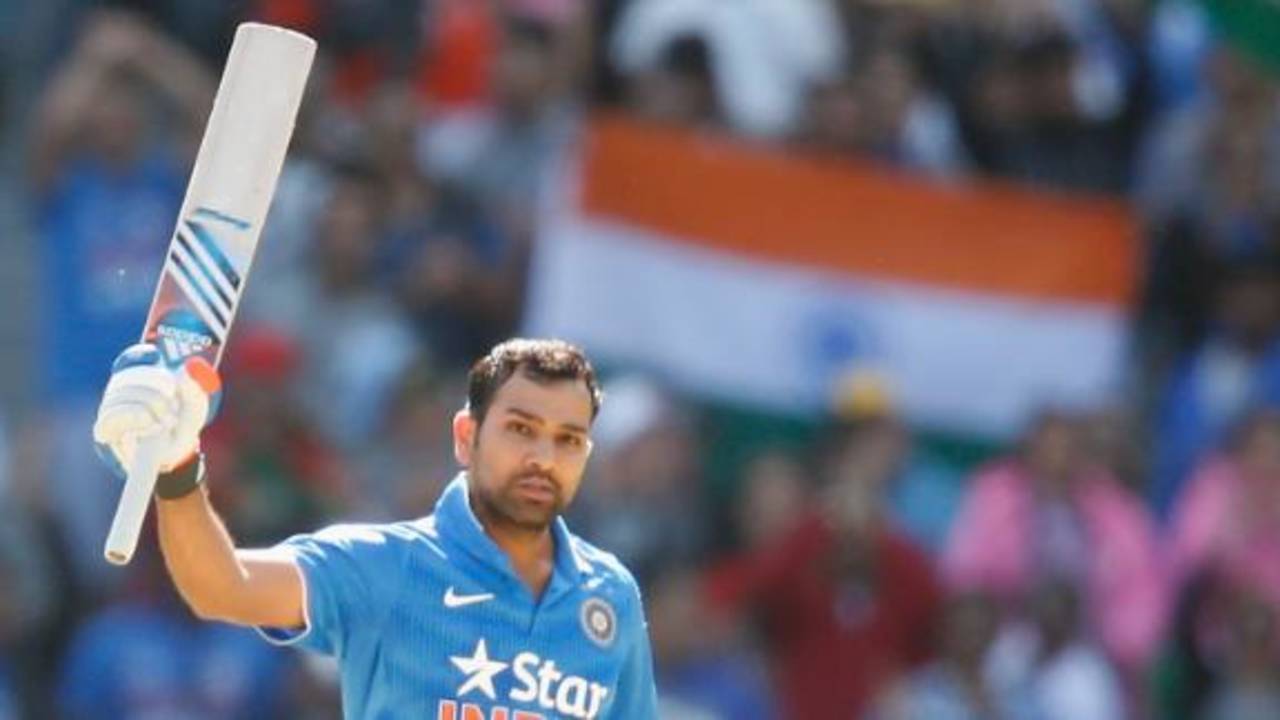Rohit finds the happy middle ground
Rohit Sharma's 138 at the MCG had a refreshing urgency, the lack of which has often confounded observers who believe he doesn't necessarily have to go slow at the start
Sidharth Monga
19-Jan-2015
Some will find it absurd that India had an ODI opening issue before the start of the triangular series in Australia and leading into the World Cup. It will come across as even more ridiculous that the problem part of the combination was Rohit Sharma, who has scored two double-centuries in the last 15 months. Both from the opening slot. Yet it was a problem.
The problem was, Rohit is not a natural opener. He likes gaps in the field when he starts an innings. At the top of an innings he doesn't get going. He eats up too many dots in the first 20 overs of an innings. Since the start of the Champions Trophy in 2013, which is when he and Shikhar Dhawan emerged as a strong opening combination for India, Rohit has struck at 3.58 runs an over in the first 10 overs. In comparison, Ahmed Shehzad has gone at 3.87 an over, Ajinkya Rahane at 4.11, Alastair Cook at 4.26, Mohammad Hafeez at 4.31, Hashim Amla at 4.66, Aaron Finch at 4.98, Dhawan at 5.07, Ian Bell at 5.10, Quinton de Kock at 5.26, Tillakaratne Dilshan at 5.27, Kusal Perera at 5.30 and David Warner at 5.48.
The counter-argument to this would be that the other openers haven't gone on to convert slow starts into double-centuries. Rohit was, after all, 25 off 36 at the end of 10 overs when he scored his first double, against Australia. He was only 12 off 25 after 10 overs before he smashed the record books with his 264. If somebody has this ability to go mammoth after building a slow platform, why not let him?
The problem arose when he couldn't lay bat to ball when opening in South Africa. In New Zealand he began to eat up the dots and get out before repaying them. Real doubts arose. At the heart of the problem was missing singles and doubles at the start of the innings. Dhawan could keep picking those up while Rohit would bottle one end up. India could manage to set themselves up for 20 big overs in the end at home, but away it got difficult; they needed a more even scoring pattern.
In between, injury to Rohit sent Rahane up the order. Rahane was industrious, got a century in England, and presented a dilemma. Rohit in the meanwhile insisted he liked the opening slot, and when he came back in Dhawan's absence, walked the talk with that 264. What would happen away from home, though?
If Melbourne is to be any evidence, Rohit has come back an improved opener. His century in India's opening match of the triangular, the highest score by any Indian at the MCG, was one of his more accomplished knocks. He built the innings with care and craft. By the end of the 10th over, he had reached 24 off 29. There had been calculated risk involved. There had been runs run - 14 out of the 24. In out-of-Asia matches in which he has lasted for 10 overs, this is the fewest dots he has faced in that period.
There was a refreshing urgency to Rohit's innings, the lack of which has often confounded observers who believe he doesn't necessarily have to go ultra slow at the start, thus putting all eggs in his own basket. There is caution required what with two new balls and only six batsmen in the side, but Rohit was getting too cautious too often. This innings is more the happy middle ground that India need from an opener.
Don't underestimate the physical demands of the innings either. In India you can push the ball into a gap and admire it as it rushes to the short boundaries on a fast outfield. Here you have to run your runs. Even if you hit a boundary, hardly any is a certainty as soon as it beats the in-field. Only 60 of Rohit's 138 came in boundaries.
There was situational awareness too. You could see he was getting tired towards the end, and would have been forgiven a slog, but once he saw Suresh Raina and MS Dhoni get out, Rohit restrained himself again, and looked to bat through till the end. This was Rohit's third-longest innings, and the first time he has faced 100 balls or more in an innings outside Asia and Zimbabwe. He couldn't quite give it the usual Rohit finish, but the more he sets himself up in this fashion the higher his chances of big finishes.
Rohit has an amazing gift for clearing boundaries towards the end of an innings. Which is why you wondered if India were making a huge sacrifice by pushing Rohit down the order. If he bats more often like he did in Melbourne, though, he can offer India the best of both worlds.
It will be an on-going tussle, though: in Melbourne you could see the biggest difference was the 22 singles he took behind square on the off side, making a conscious attempt to open the face whenever given the length or width. Expect teams to block that area better in the future. What will Rohit's next move be?
Sidharth Monga is an assistant editor at ESPNcricinfo
